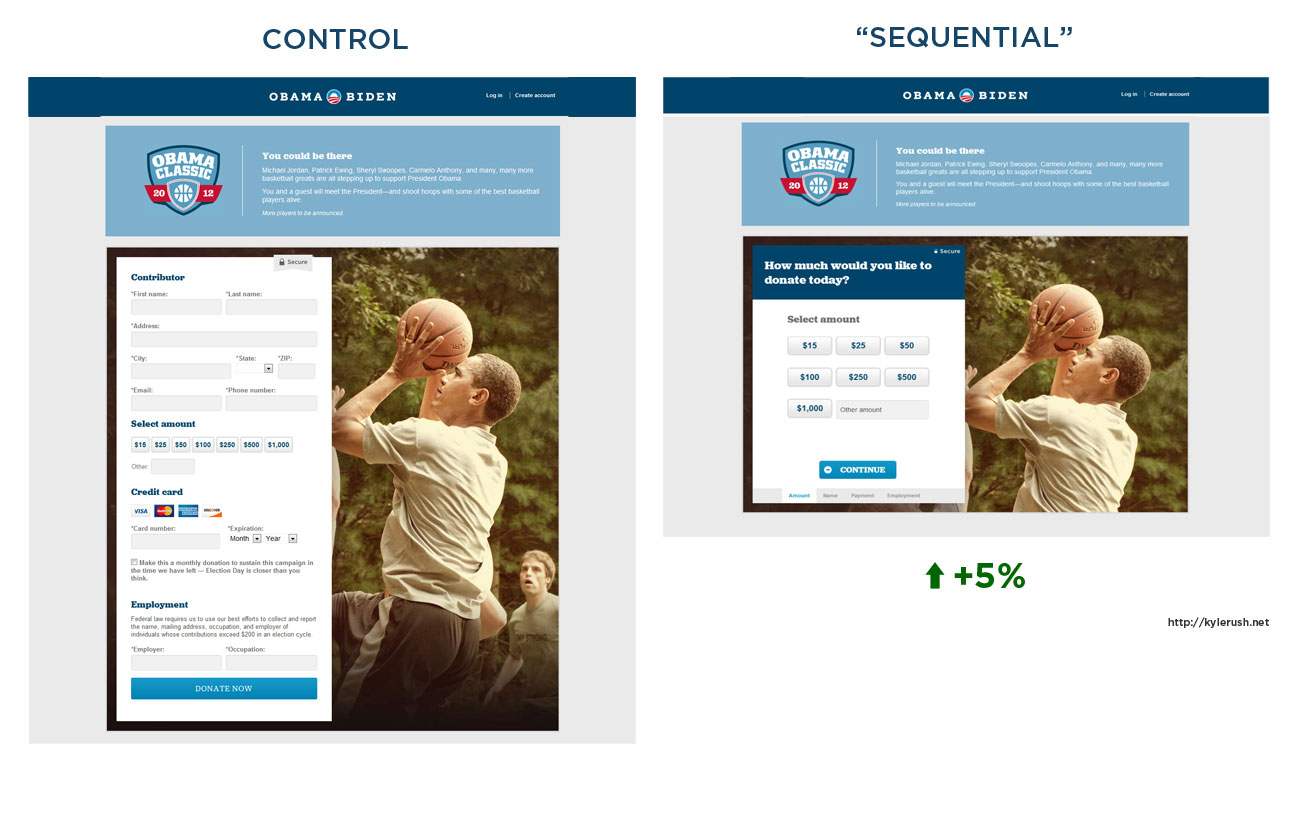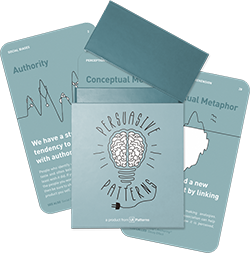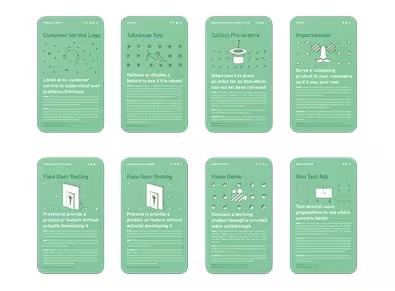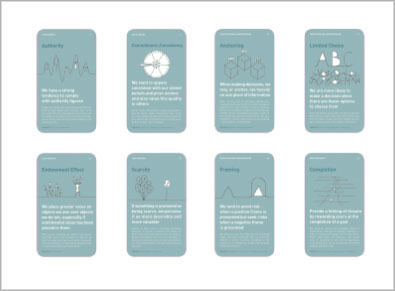Commitment & Consistency
Design Pattern
Problem summary
We want to appear consistent with our stated beliefs and prior actions and also value this quality in others
Example

▲ By breaking the donation process up into sequential steps, the campaign increased donation conversions by 5%, collecting millions of incremental dollars. People like to see themselves as consistent and rational – getting started with the donation amount committed them to finishing what they had started.
Usage
- Use when the possibility of customers agreeing to your terms up front are unlikely.
- Use when you want to help change the attitudes and beliefs of your users.
This card is part of the Persuasive Patterns printed card deck
The Persuasive Patterns Card Deck is a collection of 60 design patterns driven by psychology, presented in a manner easily referenced and used as a brainstorming tool.
Get your deck!Solution
Find ways to make people state their agreement to a decision in order to pave way for similar and larger commitments in the same category, later.
Ask for small commitments or easy agreements to pave the way for bigger commitments later. To get to a more substantial agreement, make it easier for your users to buy in early and small; it will be easier for them to buy in later and larger.
Simple ways of using the Commitment and Consistency principle in web design includes:
- Add a checkbox to your form with a small action that connects to the behavior your wish to reinforce later. Adding a checkbox saying “YES! I am ready for a better rate today!” increased conversions by 11%1. Takeaway: Ask for a very small commitment upfront.
- Move the commitment up front. By breaking the donation process up into sequential steps, the Obama campaign increased donation conversions by 5%2, collecting millions of incremental dollars. People like to see themselves as consistent and rational – getting started with the donation amount committed them to finishing what they had started. Takeaway: Break up your “asks” into manageable steps.
Make the commitment positive and personalized. Sart your sentence with “Yes!” and personalize the headline – for example “Yes – I am ready to improve my website’s conversion rate!”
Getting commitments to work
- Find relevant ways. Look for positive, relevant ways to encourage people to make public, active, and voluntary commitments – and build on those.
- Small commitments pave the way. Ask for small commitments or easy agreements, to pave the way for even bigger commitments. To get to a more substantial agreement, make it easier for your users to buy in early and small. And it will be easier for them to buy in later and larger.
- Build momentum. Look for opportunities achieve small wins that demonstrate progress – and the direction of your larger persuasive objective.
Getting it Right
With the goal of not manipulating, but rather, fostering genuine, positive actions that benefit both individuals and organizations, these are effective implementation strategies:
- Start Small. Utilizing the Foot-in-the-Door technique, begin with a minor request that a person is likely to agree to. This can pave the way for larger, related requests. For example, asking users to sign up for a newsletter can increase the likelihood of them making a purchase later.
- Public Commitments. When people make commitments publicly, they’re more likely to follow through. This is because public declarations not only influence the individual’s self-perception but also create a sense of accountability to others.
- Writing it Down. There’s power in the written word. When individuals write down their commitments or beliefs, it reinforces their attachment to them. This is why testimonials or setting written goals can be so influential.
- Positive and Personalized Commitments. Frame commitments in a positive light and personalize the request. Starting a commitment with affirmations like “Yes!” or personalizing the commitment to the individual can make it more compelling.
- Not all commitments are equal. Just because someone agrees to a minor request doesn’t guarantee they’ll agree to a larger, related one.
- Sequential steps. Breaking processes into manageable steps can increase user engagement and completion rates.
- Affirmative actions. Incorporate checkboxes or options that affirm a user’s commitment. This can be as simple as a checkbox saying, “Yes, I want to stay updated!”
Rationale
People like to be consistent with the things they have previously said or done. People generally want to be seen, as honoring their commitments consistently; as somebody who can be counted on, instead of somebody who flip flops, and is without self-control.
Once we have publicly said out loud, that we use or like a product or that we are going to start doing something, we have a desire to act in a manner consistent with that behavior. If I state that I am going to start running 3 times a week, I have a desire to act consistently with that statement.
People have an innate desire to be consistent with their words and actions. This desire is so strong that individuals will sometimes go to great lengths to maintain consistency, even when doing so may not be in their best interests.
Why is this so?
- Cultural value. Consistency is often valued in societies. Inconsistent individuals can be viewed as unreliable or deceitful.
- Self-perception. Once we commit to something publicly, we tend to act in ways that are congruent with that commitment. This aligns with our self-image and how we want others to perceive us.
- Cognitive ease. Being consistent reduces the cognitive load. It’s simpler to continue in a set pattern than to evaluate every decision afresh.
Discussion
For commitments to be powerful, they need to be public, be actively followed up by an action, and voluntary. Every time we make a public commitment, we slowly change our attitudes toward that commitment. If we say, we use a product, but have actually only used it a couple of times, we have a tendency to change our behavior toward starting to use the product more, in order to act consistently with our public commitment. That in turn can lead to even more use of the product, which then might invoke another commitment. So it turns out to be this self-fulfilling cycle of larger and larger commitments.
The key is to make people state their position, declare their intentions, or show a small gesture of support. Generally, people will act in a manner consistent with these small requests,
even if later asked to make a much larger, but consistent, commitment.
Getting just a small commitment from your potential customers, like getting them to sign up for your newsletter or liking your page on Facebook, will make them more likely to purchase from you, in the future.
We will go a long way to avoid a strong dissonance, between our words and our actions. If we say we will do a thing, we feel we must, even if following through on our words, is actually irrational.
1 11% conversion rate increase with a “Commitment Checkbox” at ConversionVodoo
2 Optimization at the Obama campaign: a/b testing by Kyle Rush
3 The Principle of Commitment and Behavioral Consistency
by Therese Fessenden
4 Freedman, J.L., & Fraser, S.C. (1966). Compliance without pressure: The foot-in-the-door technique. Journal of Personality and Social Psychology, 4(2), 195-202.
5 Cialdini, R. B. (2001). Influence: Science and Practice. Allyn & Bacon.
6 Kiesler, C. A. (1971). The psychology of commitment. Academic Press.
7 Festinger, L. (1957). A theory of cognitive dissonance. Stanford University Press.
8 Thaler, R. H., & Sunstein, C. R. (2008). Nudge: Improving decisions about health, wealth, and happiness. Yale University Press.
9 The Commitment & Consistency influence technique at Learning Loop
User Interface Design Patterns
- Forms
- Explaining the process
- Community driven
- Tabs
- Jumping in hierarchy
- Menus
- Content
- Gestures
- Tables
- Formatting data
- Images
- Search
- Reputation
- Social interactions
- Shopping
- Increasing frequency
- Guidance
- Registration
Persuasive Design Patterns
- Loss Aversion
- Other cognitive biases
- Scarcity
- Gameplay design
- Fundamentals of rewards
- Gameplay rewards


